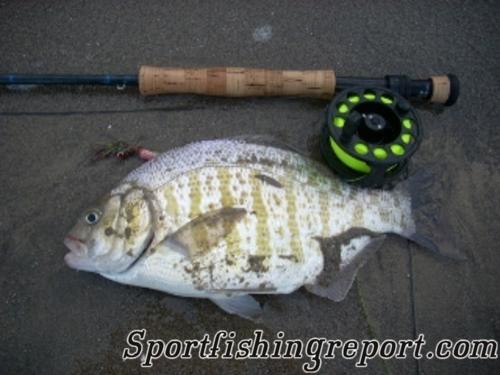From Sportfishing
Fish Report for 12-25-2008

Sentinel Fish Report
12-25-2008
Allen Bushnell
A series of large arctic-type storms have battered our coast this week. Most anglers are keeping dry at home. The storms should, however, start to produce the beach structure we need for wintertime perch fishing. A small number of barred surf perch have been reported caught over the past few weeks. As we move into January we will see increasing concentrations of these gamefish, and surfcasters will walk the beaches to find deep spots, holes and rip currents that hold feeding schools.
Almost any beach along Monterey Bay can produce great fishing for surfperch. It is a matter of being at the right place at the right time, and learning to recognize the conditions that the perch favor. Large waves and heavy currents from winter storms move sand along the beaches. The sand builds up in some spots, and is naturally dredged in other areas. The savvy surfcaster looks for deep-water spots along the edge of the beach.
Perch will usually hang along the edge of these deeper areas, and feed on the sandcrabs and other small fish that are swept along in the currents. Currents can take the form of sideways- moving littoral currents, or rip currents which head straight out to sea. Surfcasters cast their bait or lures into the current, or along the seam of the current to fool the perch. Perch are also found just behind the breaking waves, and sometimes in the flat foamy areas created as the waves roll in. Some of the popular perch fishing beaches include Twin Lakes Beach, Capitola Beach, New Brighton, Rio Del Mar, Manresa and any of the beaches south of Moss Landing. Many surfcasters prefer to fish the incoming high tide for perch, but any tide can produce if the correct structure and moving water is in place.
Most surfcasters use an eight to eleven-foot rod with spin casting or conventional reels. These fish are small, so six to eight pound test line is usually sufficient. Anglers using bait will typically rig a pyramid sinker on the end of their leader. The leader itself has dropper loops for the hooks, and bait can be mussels, pileworms, shrimp bits or the favorite sandcrabs. Bait anglers cast out beyond the waves, and let their bait stay put until they see a nibble.
More often these days, surfcasters will use small 1 ?? or 2-inch plastic grubs as a lure. This is a more active form of fishing, casting and retrieving the lure within the preferred zone. The grub is threaded onto the hook, and run on a three-foot leader below a sliding egg sinker. In Monterey Bay, the gold or red-flaked motor oil grubs work very well, though pink or chartreuse grubs have also been know for success. We have a growing contingent of fly-casting surf anglers here who use a variety of streamer-type flies to mimic the perch's natural prey, and do quite well once they get the hang of it.
Surfcasting for perch is a challenging and rewarding pursuit. The fish are small, but with light gear the fight can be terrific. Perhaps the best rewards are the long walks on deserted wintertime beaches looking for the correct conditions, trying a few casts at every likely spot. Practice this often enough, and you are sure to be rewarded with a "honey-hole" all your own where there is a fish for every cast and legendary tales to be composed.
Photos
< Previous Report Next Report >

Website Hosting and Design provided by TECK.net
